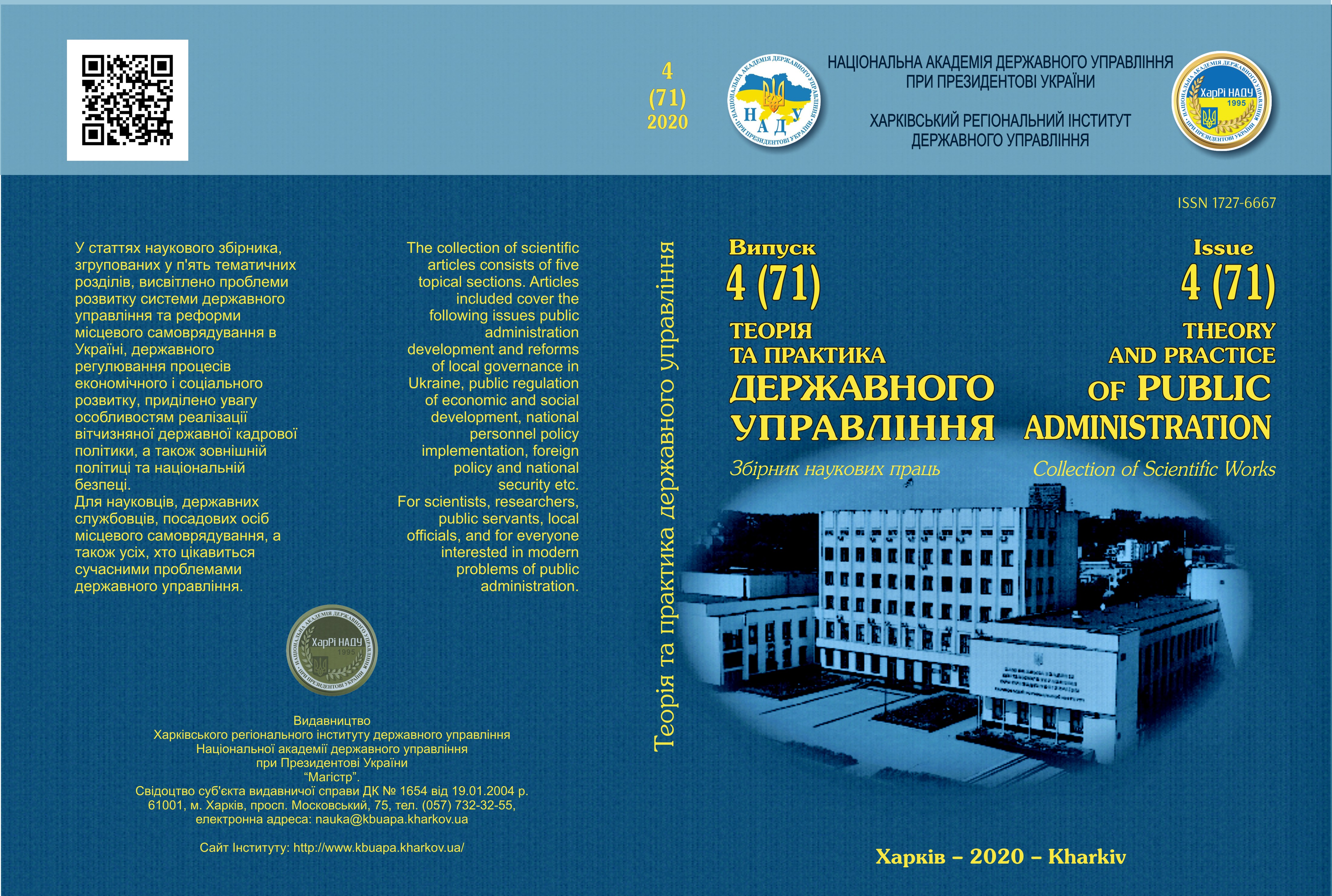MODELS OF CREATING THE ARCHITECTURE OF E-GOVERNMENT: WORLD EXPERIENCE AND UKRAINIAN REALITIES
Abstract
The article analyses e-government models and ways to implement them in Ukraine.
The models are studied regarding development (initial steps) and implementation of e-government programs. They are described with the appropriate stages of their formation, definition and analysis of each step. The specific models of K. Lane and J. Lee (2001), K. Baum and A. DiMaio (2000), UN (2001), J. Hiller and F. Belanger (2001), C. Wescott (2001) envisage gradual and linear development of e-government, mainly through such stages as: transaction, interaction, integration, access to e-government, provision of information by the government and provision of services, e-democracy, e-participation, government transformation, or various combinations of the above.
The description of models indicates the challenges facing the implementation of e-government programs and the differences that exist between countries (or within one country). The description shows that the models differ in the number of stages (steps) of their implementation: some models were based on four stages, and others – on five, six stages. This difference may be related to the vision and goals set by the government or the challenges faced by e-government programs.
However, these models suggest that e-government dissemination (interactive, transactional, and integrated) should be implemented by the governments to provide transactions, interoperability, and integration. E-government should promote e-democracy or participatory democracy and encourage positive developments in government-public relations.
The trends for Ukraine to use these e-government models are revealed. It is concluded, that Ukraine is still at the early stages of efficient implementation of information and communication technologies. The governmental authorities are to improve the management of financial information and reporting in order to simplify the provision of public services, expand their communication with the citizens. Besides, there are differences in the implementation of models due to the “centralization-decentralization” of this process.
Downloads
References
Abramenko, Y. Zarubizhny dosvid e-vryaduvannya ta problemy jogo implementaciyi v Ukrayini [Foreign experience of e-government and problems of its implementation in Ukraine]. URL: http://www.dridu.dp.ua/zbirnik/2009-02/09ayypiu.pdf [in Ukrainian].
Gubernskyj, L., Kamenskyj, Ye., Makarenko, Ye. and other. (2007). Informacijna polityka Ukrayiny: yevropejskyj kontekst [Information policy of Ukraine: European context]. Kyiv: Lybid [in Ukrainian].
Al-Khouri, A., Bal, J. (2007). Electronic government in the GCC countries. International Journal of Social Sciences, 1 (2), 83–98.
Andersen, K.V., Henriksen, H.Z. (2006). E-Government Maturity Model: Extension of the Layne and Lee Model. Government Information Quarterly, 23, 236–248.
Azab, N.A. (2009). Assessing electronic government readiness of public organizations. Communications of the IBIMA, 8 (13), 95–106.
Coursey, D., Norris, D.F. (2008). Models of e-government: Are they correct? An empirical assessment. Public administration review, 68 (3), 523–536.
Fath-Allah, A. et al. (2014). E-Government Maturity Models: A Comparative Study. International Journal of Software Engineering and Applications, 5 (3), 71.
Hiller, J.S., Belanger, F. (2001). Privacy strategies for electronic government. E-government, 162–198.
Layne, K., Lee, J. (2001). Developing fully functional E-government: A four stage model. Government Information Quarterly, 18, 122–136.
Ronaghan, S.A. (2001). Benchmarking E-Government: A Global Perspective. New York: United Nations Division for Public Economics and Public Administration and American Society for Public Administration. URL: https://publicadministration.un.org/egovkb/portals/egovkb/documents/un/english.pdf.
Szeremeta, J. (2002). Benchmarking e-government: a global perspective. International congress on government on line. Ottawa, Canada: United Nations 12. Online Network in Public Administration and Finance (UNPAN). URL: http://unpan1.un.org/intradoc/groups/public/documents/un-dpadm/unpan038855.pdf.
Wescott, C.G. (2001). E- Government in the Asia - pacific region. Asian Journal of Political Science, 9 (2), 1–24.
Yildiz, M. (2007). E-government research: Reviewing the literature, limitations, and ways forward. Government Information Quarterly, 24 (3), 646–665.
Authors who publish with this journal agree to the following terms:
- Authors retain copyright and grant the journal right of first publication with the work simultaneously licensed under a Creative Commons Attribution License that allows others to share the work with an acknowledgement of the work's authorship and initial publication in this journal.
- Authors are able to enter into separate, additional contractual arrangements for the non-exclusive distribution of the journal's published version of the work (e.g., post it to an institutional repository or publish it in a book), with an acknowledgement of its initial publication in this journal.
- Authors are permitted and encouraged to post their work online (e.g., in institutional repositories or on their website) prior to and during the submission process, as it can lead to productive exchanges, as well as earlier and greater citation of published work (See The Effect of Open Access).

